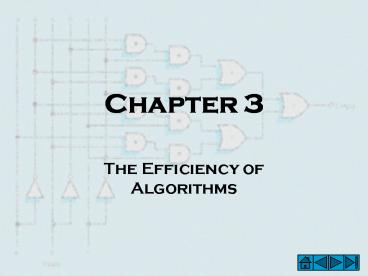The Efficiency of Algorithms - PowerPoint PPT Presentation
1 / 46
Title:
The Efficiency of Algorithms
Description:
Chapter 3 The Efficiency of Algorithms Chapter 3 The Efficiency of Algorithms Figure 3.18 Selection Sort Algorithms Exchanging the Values of X and Y Figure 3.21 ... – PowerPoint PPT presentation
Number of Views:38
Avg rating:3.0/5.0
Title: The Efficiency of Algorithms
1
Chapter 3
- The Efficiency of Algorithms
2
Figure 3.3 A Choice of Algorithms
3
Figure 3.3.1 The Shuffle-Left Algorithm
Original Configuration
4
Figure 3.3.1 The Shuffle-Left Algorithm The
Value of Legit- First Copy
5
Figure 3.3.1 The Shuffle-Left Algorithm The
Value of Legit Second Copy
6
Figure 3.3.1 The Shuffle-Left Algorithm The
Value of Legit The Third Copy
7
Figure 3.3.1 The Shuffle-Left Algorithm- The
Value of Legit After Last Item is Copied, the
Result is This
8
Figure 3.3.1 The Shuffle-Left Algorithm The
Value of Legit Reset the Right Hand Finger to
Start Again
9
Figure 3.3.1 The Shuffle-Left Algorithm The
Value of Legit Left and Right Hand Finger Move
Forward
10
Figure 3.3.1 The Shuffle Left Algorithm The
Value of Legit Moving along, we pass over the
16.
11
Figure 3.3.1 The Shuffle-Left Algorithm The
Value of Legit-Seven Copies squeeze out O
12
Figure 3.3.1 The Shuffle-Left Algorithm The
Value of Legit - The 36, 42, 23, and 21 Are
Passed Over This is the Result
13
Figure 3.3.1 The Shuffle-Left Algorithm The
Value of Legit Squeezing out Final 0 Gives This
Result
14
Figure 3.3.1 The Shuffle Left Algorithm The
Value of Legit The Left Hand Finger is Pointing
At a Nonzero Element, so Another Advance of Both
Fingers Gives Us This Configuration.
15
Figure 3.3.2 The Copy-Over Algorithm
16
Figure 3.3.3 The Converging-Pointers Algorithm
The Value of Legit
17
Figure 3.3.3 The Converging-Pointers Algorithm
The Value of Legit Legit and Right Are Reduced
by 1.
18
Figure 3.3.3 The Converging-Pointers Algorithm
The Value of Legit The Value of Left Increases
19
Figure 3.3.3 The Converging-Pointers Algorithm
The Value of Legit Position Right is Copied
Into Position Left
20
Figure 3.3.3 The Converging-Pointers Algorithm
The Value of Legit Item at Position Left is
Still 0, Another Copy Takes Place
21
Practice Problems - In the Data Cleanup Problem,
Suppose the Original Data Is Like This
22
Figure 3.6 Values of Magnitude Work 2n
23
Figure 3.7 Order of Magnitude - Work cn for
Various Values of c
24
Figure 3.8 Order of Magnitude Growth of Work
cn for Various Values of c
25
Figure 3.9 Order of Magnitude -Table of Calling
Information
26
Figure 3.10 Order of Magnitude Work cn2 for
Various Values c
27
Figure 3.11 The 0rder of Magnitude A
Comparison of n and n2
28
Figure 3.12 Order of Magnitude For Large
Enough n, 0.25n2 Has Larger Values than 10n
29
Figure 3.13 Order of Magnitude A Comparison of
Two Extreme T (n2) and T (n) Algorithms
30
Using the Information in Figure 3.5 Fill in the
Above Table for the Number of Comparisons
required in the Sequential Search Algorithm
31
Figure 3.14 Analysis of Algorithms Analysis of
Three Data Cleanup Algorithms
32
Figure 3.16 Selection Sort Algorithms
Comparisons Required by Selection Sort
33
Figure 3.17 Selection Sort Algorithms - An
Attempt to Exchange the Values at X and Y
34
Figure 3.18 Selection Sort Algorithms
Exchanging the Values of X and Y
35
Figure 3.21 Binary Search Values of n and lg n
36
Figure 3.22 Binary Search A comparison of n
and lg n
37
Figure 3.23 Summary Order-of-Magnitude Time
Efficiency Summary
38
Figure 3.24 When Things Get Out of Hand Four
Connected Cities
39
Figure 3.25 When Things Get Out of Hand
Hamiltonian Circuits Among All Paths from A in
Figure 3.24 with Four Links
40
Figure 3.26 (a) When Things Get Out of Hand
Comparisons of lg n, n, n2, and 2n
41
Figure 3.26 (b) When Things Get Out of Hand
Comparisons of lg n,n, n2, and 2n
42
Figure 3.28 Approximation Problems A First-Fit
Solution to a Bin-Packing Problem
43
Practice Problems Tree Shows All Paths with Two
Links That Begin At Node A
44
Exercises Write the Data List that Results from
running the Shuffle-Left Algorithm to clean up
this Data
45
Exercises A Linked List
46
Exercises Draw a Linked List when Data Cleanup
is Performed on This Linked List

